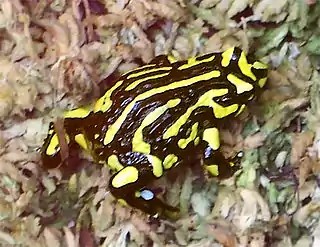| Southern corroboree frog | |
|---|---|
 | |
| Scientific classification | |
| Domain: | Eukaryota |
| Kingdom: | Animalia |
| Phylum: | Chordata |
| Class: | Amphibia |
| Order: | Anura |
| Family: | Myobatrachidae |
| Genus: | Pseudophryne |
| Species: | P. corroboree |
| Binomial name | |
| Pseudophryne corroboree Moore, 1953 | |
The southern corroboree frog (Pseudophryne corroboree) is a species of Australian ground frog native to southeastern Australia.[2][3]
The species was described in 1953 by Fulbright research scholar John A. Moore from a specimen collected at Towong Hill Station at Corryong, Victoria, and sent to the Australian Museum. The curator Roy Kinghorn recognised it as a new species and allowed Moore to describe it.[4]
Description
Adult female southern corroboree frogs are 26–31 mm (1.0–1.2 in) long, while males measure 22–29 mm (0.87–1.14 in);[5] both bear vivid yellow and black stripes across the head, back and limbs. The body and head are short and wide, the snout has a slight point, and the fingers and toes lack webbing. The iris is black.[6] The northern corroboree frog has narrower and more greenish-yellow striping.[5]
Habitat and conservation
The southern corroboree frog is native to Kosciuszko National Park in the northern Snowy Mountains, where it is found at locales between the Maragle Range and Smiggin Holes.[7] Reported as abundant during the 1970s,[6] it declined drastically during the 1980s from chytridiomycosis.[8] The species is critically endangered,[1] with the wild population thought to number around 30 individuals.[9] The natural habitat is sphagnum bog at elevations greater than 1,200 m (3,900 ft).[6]
Efforts to conserve the species have included establishing captive breeding programs across four institutions: the Amphibian Research Centre in 1997, Melbourne Zoo in 2001, Taronga Zoo in 2006, and Healesville Sanctuary in 2007.[8] By 2018, there were over 400 southern corroboree frogs in zoos.[10]
Five breeding enclosures have been established in Kosciuszko National Park. Two-thirds of the frogs in these perished in the 2019–20 Australian bushfires. In 2022, a further 100 frogs were released from captive breeding programs.[9]
References
- 1 2 Jean-Marc Hero; Frank Lemckert; Peter Robertson; Harold Cogger & Murray Littlejohn (2004). "Pseudophryne corroboree". IUCN Red List of Threatened Species. 2004: e.T18582A8484537. Retrieved 25 March 2022.
- ↑ Australian Biological Resources Study (20 March 2013). "Species Pseudophryne corroboree Moore, 1953". Australian Faunal Directory. Canberra, Australian Capital Territory: Department of the Environment, Water, Heritage and the Arts, Australian Government. Retrieved 25 March 2022.
- ↑ Frost, Darrel R. (2022). "Pseudophryne corroboree Moore, 1953". Amphibian Species of the World: An Online Reference. Version 6.1. American Museum of Natural History. doi:10.5531/db.vz.0001. Retrieved 2 May 2022.
- ↑ Moore, J. A. (1953). "A new species of Pseudophryne from Victoria". Proceedings of the Linnean Society of New South Wales. 78 (3–4): 179–180.
- 1 2 Tyler, Michael (2020). Field Guide to the Frogs of Australia. CSIRO Publishing. p. 144. ISBN 9781486312474.
- 1 2 3 Swan, Michael (2020). Frogs and Reptiles of the Murray-Darling Basin A Guide to Their Identification, Ecology and Conservation. CSIRO Publishing. pp. 41, 67. ISBN 9781486311330.
- ↑ Office of the Environment & Heritage (7 June 2021). "Southern Corroboree Frog - profile". Threatened Species. Australian Government. Retrieved 30 March 2022.
- 1 2 Mcfadden, Michael; Hobbs, Raelene; Marantelli, Gerry; Harlow, Peter; Banks, Chris; Hunter, David (2011). "Captive management and breeding of the Critically Endangered Southern Corroboree Frog (Pseudophryne corroboree) (Moore 1953) at Taronga and Melbourne Zoos". Amphibian & Reptile Conservation. 5 (3): 70–87.
- 1 2 Proust, Keira (30 March 2022). "Critically endangered southern corroboree frog conservation efforts ramp up". ABC News. Australian Broadcasting Corporation. Retrieved 25 March 2022.
- ↑ Garnett, Stephen; Woinarski, John; Lindenmayer, David; Latch, Peter (2018). Recovering Australian Threatened Species: A Book of Hope. CSIRO Publishing. pp. 281–284. ISBN 9781486307425.
